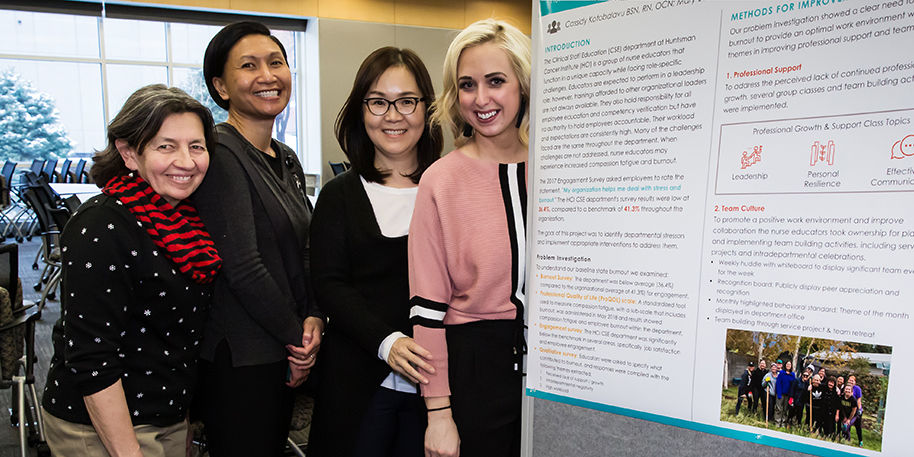
Childress at age seven playing nurse with siblings.
It Was All About the Uniform
I knew I wanted to be a nurse when I was six years old. That year, my unmarried uncle informed me that his date to our 4th of July picnic was A NURSE. I was so excited. The first question I asked, "Will she wear her uniform?" Of course she wasn’t planning to wear her dirty uniform from the VA Hospital in Buffalo, New York. But once she heard how excited I was, she couldn’t disappoint me. She arrived in her full white uniform, white stockings, white shoes, cap and wool cape. She sent me a nursing uniform with the hat for Christmas that year. I was six, and I was sold. It was all about that uniform.
How can I do it better?
Once I became that uniformed nurse with my own white hat (which I still have in my office), an early memory of being a nurse is asking my manager, “How can I do it better?” If I didn’t like a patient education form, I would ask to do some research to see what else was available. I was lucky because I had great bosses. Rather than pushing my ideas aside or taking my ideas, they supported and challenged me, sending me to next steps like literature review or securing physician buy-in. I was given access, mentoring, time, and tools to learn how I could make things better.
I’ve tried to use these lessons and others to create that enthusiasm for improvement here. Starting with teams I’ve managed and expanding to University of Utah’s Evidence Based Practice Committee, my goal is to create an environment of improvement that starts small and can grow as large as you want.
The Progress Principle
In her nationally recognized research, Harvard Professor Teresa Amabile explains that organizations can foster innovation through three forces:
(1) Consideration for people and their ideas
Honor the dignity of employees, value their ideas and welcome individual contributions.
(2) Coordination
Align employees with organization’s goals. Create procedures to smooth collaboration between individuals and groups.
(3) Communication
Clear, honest, respectful and free-flowing communication is essential to sustain progress, establish trust and convey the value that people and their ideas contribute to the organization.
From: The Progress Principle , T. Amabile & S. Kramer, Harvard Business Review Press 2011 p. 109.
SSue’s tips for fostering innovation
#1 Ask for ideas
It always starts with leadership. Let your staff know that you're very interested in being innovative. Let them know you’re interested in best practices—whether from inside the organization, meetings or even other industries. Let them see that you are always looking at ways to improve. If you want to keep the ideas focused, start with our three goals: patient experience, quality and finance. Just introducing the opportunity to improve and asking for ideas is an important step.
#2 Teach them to fish
Sometimes a person’s first or second improvement project is hard. You might have to spend more time on it. It’s important to look at this work as an investment in the future. Soon your employees will look forward to improving everything about the work. They will be excited about making a difference and there is so much intrinsic satisfaction in that for them and for you.
The challenge is when things get uncomfortable. Don’t take over, but instead, guide them through. We set the assumption right from the beginning that the employee will guide the work with our management team's support. My job is to instill excitement and to walk them through. I coach by saying “This is a great idea. Let’s talk about how you can review it with the other team members…” The first thing I teach them is the importance of keeping your boss in the loop because your boss can provide crucial mentoring and identify resources.
I always remind people to be proud of your efforts. It’s important to be proud, whether you’re successful and even when you’re not. You are trying to make things better.
#3 Leverage student resources
If your barrier is that there isn’t enough time, consider engaging with students. Explore opportunities to sponsor interns or identify students that need some hours. I've reached out to the College of Nursing to ask, "Do you have anybody in your master's program that needs to do a project? I have a physician and a nurse over here that want to do a project. They need somebody to do some leg work.” It’s such a great opportunity for a student to know that our clinicians would like their help to make patient care better.
#4 Join the Evidence Based Practice Council
The Evidence Based Practice Council began as an idea. I felt strongly that as an academic medical center, we should be doing nursing research. We started with about ten staff nurses and partnered with enthusiastic faculty from the College of Nursing. We quickly realized we needed pharmacists, physicians, therapists, and other professionals and opened the council to all. We’re now a strong and diverse group of clinicians. We meet monthly to grow our improvement and research skills through lunch and learn sessions, regional improvement meetings, and learning from the improvements of others. It’s exciting to see our organization’s passion for improvement grow.
Six years ago, the council sponsored our first poster session of system improvement. The enthusiasm to share scholarship is contagious, and this year we will have tripled in size. This year’s EBP Poster Session will include over 60 projects and will be hosted electronically on e-channel.
Sue Childress
You have a good idea about what you want to study, compare, understand or change. But where do you go from there? First, you need to be clear about exactly what it is you want to find out. In other words, what question are you attempting to answer? Librarian Tallie Casucci and nursing leaders Gigi Austria and Barb Wilson help us understand how to formulate searchable, answerable questions using the PICO(T) framework.
EBP, or evidence-based practice, is a term we encounter frequently in today’s health care environment. But what does it really mean for the health care provider? College of Nursing interim dean Barbara Wilson and Nurse manager Gigi Austria explain how to integrate EBP into all aspects of patient care.
Teaching the next generation of health care providers happens every morning in 10 minute chunks throughout the hospital. The Surgical Intensive Care Unit reimagined the physician rounds to feature the patient’s nurse, instead of the patient’s physician-student. They found that this simple change created a stronger interprofessional team and advanced nursing practice.
